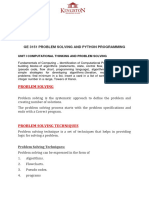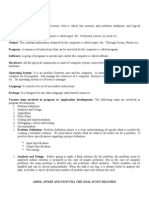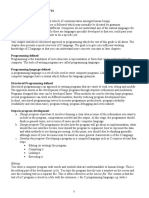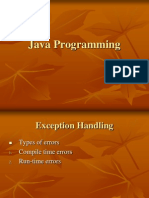Information Sheet No 1.1
Information Sheet No 1.1
Uploaded by
Dexter De LunaCopyright:
Available Formats
Information Sheet No 1.1
Information Sheet No 1.1
Uploaded by
Dexter De LunaCopyright
Available Formats
Share this document
Did you find this document useful?
Is this content inappropriate?
Copyright:
Available Formats
Information Sheet No 1.1
Information Sheet No 1.1
Uploaded by
Dexter De LunaCopyright:
Available Formats
3333333333333333333333333
Information Sheet No 1.1
INTRODUCTION TO PROGRAMMING
Learning Outcomes:
At the end of the lesson, the student should be able to:
Familiarize the basic programming terminology
Describe data representation and manipulation
Explain how algorithms and processing programs work
Implement a simple program by writing the code, testing the code and debugging the program
Lyceum of Alabang Computer Programming 1
INTRODUCTION TO PROGRAMMING
Nowadays, computers have become irreplaceable. We use them to solve complex problems at the
workplace, have fun and communicate. Despite the fact that computers are so widespread, computers still rely
on human beings who will feed set of instructions to carry out a task. These instructions are called program, and the
person who write the program are called programmer.
How do computers understand the instruction given to it by the programmer? Because the computer is
powered by electricity, it can only understand an on or off switches as represented by 1 or 0. Programmers had to
write program instruction using a series of 1’s or 0’s called machine language or low-level language. As computer
technology evolves, the assembly language was developed which simplifies the very tedious task of writing a series
of 1’s or 0’s through alphabetic abbreviations called mnemonic code. Programs written in assembly language
require an assembler (other program) to convert the assembly code to machine code.
The rapid growth of computer hardware technology affects many programmers to develop another
programming language allowing them to use instruction that more closely resemble the English language called
high-level language. This language requires either an interpreter or a compiler to convert the English-like
instructions into machine language. There are many programming languages available in the market today. These
include C Sharp (contained on this manual), C, C++ COBOL, VB, VB.Net, etc. Compiler and interpreter is needed
to translate the instructions from high-level language to low-level language
Logic formulation and problem-solving skills are the fundamentals of programming. It requires intricate
process of critical and analytical thinking with precision and intensity to details. With this, planning is very
important because it serves as the backbone of any program.
ALGORITHM AND PSEUDOCODE
Algorithm is a finite set of instructions for carrying out some process step by step. This is the process
where the problem breaks down into simple steps so that the right answer may yield. A recipe in a cookbook is an
example of an algorithm. The complicated preparation of a dish is broken down into simple steps that even an
inexperience person in cooking can understand.
Pseudo code is an algorithm in English statements. It conveys the instructions before coding it using a
programming language such as C Sharp. The series of step-by-step instruction is outlined in an English word and
translate it to a language understandable by the computer.
STEPS IN SOLVING A PROBLEM
Historically, man has always tried looking for ways to simplify work and to solve problems more
efficiently. Such problems may involve numbers and quantities, which resulted to the better ways of counting using
mathematical operation. Regardless of the problem a man encounters, solving a problems involves the following;
1. Study the problem
2. Data gathering
3. Process the gathered data
4. Arrive at the solution
THE PROGRAMMING CYCLE
The computer is basically a problem-solving tool provided with a valid set of instructions by the
programmer becoming the computer a self-operational, that is, human intervention is not needed during the process
anymore. The five steps below should generally perform in sequence so as to attain an effective problem-solving
tool.
Information Sheet No 1.1 Page 2
Lyceum of Alabang Computer Programming 1
1. Define what has to be done or what problem has to be solved. The basic to planning a solution.
2. Planning a solution to the problem – Selecting the best method for solving a problem. It commonly
involves determining sequence of steps in solving a problem using pictorial representation.
3. Coding the solution – translating the series of steps into a code understandable by the computer to execute
4. Checking out the program by debugging and testing – Checking for any possible errors like logical and
syntax.
5. Documentation – Write up of the full specifications for other program users.
Example 1:
The radius of a circle is equal to three unit. Device an algorithm that will compute and display the area of the circle.
Algorithm steps:
1. Define the value of the radius (r).
2. Define the value of the pi = 3.1416
3. Calculate the area of the circle using the formula,
area = pi * r * r
4. Print the computed area
Example 2:
Compute the average quiz grade obtained by the students in his 3 quizzes. If the average is greater than or equal to
75, the remarks “passed” will be printed. Otherwise, if it is below 75, the remarks “failed” will display instead.
Algorithm steps:
1. Define the value of the 3 quizzes scored by the student
Let Q1 be the value of the first quiz
Q2 be the value of the second quiz
Q3 be the value of the third quiz
2. Compute the average grade (AVG) using the formula
AVG = (Q1 + Q2 + Q3) / 3
3. If the average grade is greater than or equal 75 then
print the word “Passed”
Else
Print the word “Failed”
Example 3:
Enter an age. If the age is less than 18, display the message “ you can not vote”. The program will only stop if the
age entered is 18 above.
Algorithm steps:
1. Define the value of the age
2. do
Enter the value of age
Information Sheet No 1.1 Page 3
Lyceum of Alabang Computer Programming 1
Print the message “you can vote”
loop
3. The program will end if age entered is 18 above.
References
Svetlin Nakov, Vaselin Kolev & Co. (2013) Fundamentals of Computer Programming with C Sharp
http://www.introprogramming.info
Information Sheet No 1.1 Page 4
You might also like
- Unit 1 - Introduction To ProgrammingDocument44 pagesUnit 1 - Introduction To ProgrammingAnurag Goel100% (1)
- Unit Ii: 2.1 Problem Solving TechniquesDocument31 pagesUnit Ii: 2.1 Problem Solving TechniquesseravanakumarNo ratings yet
- Unit1 C SreedharDocument27 pagesUnit1 C Sreedhargopichandchandra466No ratings yet
- Intro To CPPDocument7 pagesIntro To CPPkalabNo ratings yet
- Problm SolvingDocument20 pagesProblm SolvingAliza HamzaNo ratings yet
- Problem Analysis Decision Tree Table Pseudocode AlgorithmDocument9 pagesProblem Analysis Decision Tree Table Pseudocode Algorithmkanchan guptaNo ratings yet
- C Programming Language2020Document92 pagesC Programming Language2020Jaamac AbdikhayrNo ratings yet
- asm1-1618- Mai Trần Nguyên KhôiDocument26 pagesasm1-1618- Mai Trần Nguyên KhôiLe Thanh Huy (FGW HCM)No ratings yet
- Module II Problem Solving Techniques: CDS101 Introduction To ComputersDocument25 pagesModule II Problem Solving Techniques: CDS101 Introduction To ComputersAlipriya ChatterjeeNo ratings yet
- Flow Chart and AlgorithmDocument5 pagesFlow Chart and AlgorithmReyn MayoyoNo ratings yet
- LEC2ADocument6 pagesLEC2Ajhaz sayingNo ratings yet
- Chapter Four Problem Solving Using ComputersDocument7 pagesChapter Four Problem Solving Using ComputersErmiasNo ratings yet
- Unit I - Part 2Document26 pagesUnit I - Part 2Danish JasonNo ratings yet
- 10th Class Computer Science Notes by Sir TahirDocument15 pages10th Class Computer Science Notes by Sir TahirTahir MehmoodNo ratings yet
- CSPaper IIDocument116 pagesCSPaper IISiddhrajsinh Zala100% (1)
- APznzaan_OyAH4nnNVM2ehVv11_rq5yt5KN4a5Pt8b2fCa-j-a-nLaL-P9ZzvwTI0HQa36mBDm8gt6ugh9j00BqR5MMI0d74wUgNrHvqCfSepprS4CG0MXWagHXYttdmtmSXgstn4KsFIRYU-t9iKMSWinHVp8jByKasCmPBCwU4kkzUL890EfgJjDJLrWa7qkyfKAbBYiLhDocument32 pagesAPznzaan_OyAH4nnNVM2ehVv11_rq5yt5KN4a5Pt8b2fCa-j-a-nLaL-P9ZzvwTI0HQa36mBDm8gt6ugh9j00BqR5MMI0d74wUgNrHvqCfSepprS4CG0MXWagHXYttdmtmSXgstn4KsFIRYU-t9iKMSWinHVp8jByKasCmPBCwU4kkzUL890EfgJjDJLrWa7qkyfKAbBYiLhasowadnoorNo ratings yet
- Basics of ProgrammingDocument85 pagesBasics of Programmingstudy onlyNo ratings yet
- Computer ProgrammingDocument33 pagesComputer ProgrammingCharisse TolosaNo ratings yet
- Introduction To Problem Solving C++Document16 pagesIntroduction To Problem Solving C++ridzuancomNo ratings yet
- 3 - Lectures Note Week4Document39 pages3 - Lectures Note Week4eaina6933No ratings yet
- Lecture # 1 (15-02-2023)Document43 pagesLecture # 1 (15-02-2023)faizymusic7No ratings yet
- Unit 1 PSPPDocument27 pagesUnit 1 PSPPkarthibalakrishnan29No ratings yet
- Lesson 1-Introduction To ProgrammingDocument7 pagesLesson 1-Introduction To ProgrammingJosephus ToledoNo ratings yet
- DD CP Chapter2Document36 pagesDD CP Chapter2Harshaa VNo ratings yet
- Computer Programming in CDocument20 pagesComputer Programming in CskrangoleNo ratings yet
- Program DevelopmentDocument12 pagesProgram Developmentphilomenamulee79No ratings yet
- Unit-2Document13 pagesUnit-2subhrakantabaral04No ratings yet
- Problem Solving Using C (Unit 1)Document29 pagesProblem Solving Using C (Unit 1)03Abhishek SharmaNo ratings yet
- chapter_3Document8 pageschapter_3belmilimohamedelamirNo ratings yet
- Characteristics of A Good Programming LanguageDocument17 pagesCharacteristics of A Good Programming Languagesouviks.phd18.ecNo ratings yet
- Problem SolvingDocument12 pagesProblem SolvingLydia AllwinNo ratings yet
- Unit I PROBLEM SOLVING AND PYTHON PROGRAMMINGDocument51 pagesUnit I PROBLEM SOLVING AND PYTHON PROGRAMMINGRaj KumarNo ratings yet
- CH 1Document34 pagesCH 1Mausam JhaNo ratings yet
- Unit III FocDocument21 pagesUnit III FocbalaNo ratings yet
- First LectureDocument38 pagesFirst LectureAhmadnur JulNo ratings yet
- 1 Introduction To ProgrammingDocument37 pages1 Introduction To ProgrammingWaheed Aslam GujjarNo ratings yet
- ARE - 510 - 6 - Programming and LanguagesDocument38 pagesARE - 510 - 6 - Programming and LanguageskhalidNo ratings yet
- GE8151 Notes PSPPDocument100 pagesGE8151 Notes PSPPaswinNo ratings yet
- Ge3151 PSPP Study MaterialDocument151 pagesGe3151 PSPP Study MaterialNathiya S Assistan Professor IT KingstonNo ratings yet
- Unit 1 GE3151 PSPPDocument37 pagesUnit 1 GE3151 PSPPrajeshwarisNo ratings yet
- Greena Dattani 1Document214 pagesGreena Dattani 1Ram Nivas PurohitNo ratings yet
- Disclaimer: College of Information and Communications TechnologyDocument33 pagesDisclaimer: College of Information and Communications TechnologyFaith Reyna TanNo ratings yet
- Introduction To Programming: C LanguageDocument18 pagesIntroduction To Programming: C LanguageJudelle Enriquez-GazaNo ratings yet
- Python Programming NotesDocument92 pagesPython Programming NotesSREEJITH S NAIRNo ratings yet
- SCSA1104 Unit 1Document25 pagesSCSA1104 Unit 1G.AkshayaNo ratings yet
- C ++ WsuDocument36 pagesC ++ Wsuhachalu50No ratings yet
- Unit 1 Probelm Solving FundamentalsDocument50 pagesUnit 1 Probelm Solving FundamentalsKalai Chelvan GNo ratings yet
- L1. Basic Programming ConceptsDocument66 pagesL1. Basic Programming Conceptsfiadhasan102No ratings yet
- Introduction To Programming: Learning OutcomesDocument44 pagesIntroduction To Programming: Learning OutcomeslloydmuyaNo ratings yet
- Pseudo CodeDocument10 pagesPseudo CodeNilanjana MaitiNo ratings yet
- Computer-Programming - C - Lecture-Notes Acme PDFDocument148 pagesComputer-Programming - C - Lecture-Notes Acme PDFRosʜʌŋNo ratings yet
- 102hal-3 College of Computer ScienceDocument102 pages102hal-3 College of Computer Scienceaah74385No ratings yet
- Assignment Brief 1 (RQF) : Higher National Certificate/Diploma in ComputingDocument20 pagesAssignment Brief 1 (RQF) : Higher National Certificate/Diploma in ComputingDuy TrungNo ratings yet
- C Language Full NotesDocument179 pagesC Language Full NotesToaster9767% (6)
- Algorithm and FlowchartDocument37 pagesAlgorithm and Flowchartdnlkaba100% (1)
- 1b) SMA 2175 Introduction To Programming in C Notes - 1-3Document26 pages1b) SMA 2175 Introduction To Programming in C Notes - 1-3kiprotich allanNo ratings yet
- Pps NotesDocument204 pagesPps Notes5377696raghav10No ratings yet
- SPM C03 PDFDocument24 pagesSPM C03 PDFJuhi KashyapNo ratings yet
- Lumberyard UgDocument1,385 pagesLumberyard UgКонстантин ПрокопьевNo ratings yet
- TMP3413 Software Engineering Lab: The Development PlanDocument41 pagesTMP3413 Software Engineering Lab: The Development PlanNurfauza JaliNo ratings yet
- Foreseer Server GuideDocument57 pagesForeseer Server GuideSealtiel G. LozaNo ratings yet
- NLINK OPC To SAP Solution Case Study - RefineryDocument3 pagesNLINK OPC To SAP Solution Case Study - RefineryPutra Saleh SiregarNo ratings yet
- 1-Microcontroller Based System Design - CompleteDocument55 pages1-Microcontroller Based System Design - CompleteWasif Bin ArifNo ratings yet
- Console I/O and File I/O: Sun Educational ServicesDocument17 pagesConsole I/O and File I/O: Sun Educational ServicesSabNo ratings yet
- Module 5 - S8 CSE NOTES - KTU DEEP LEARNING NOTES - CST414Document26 pagesModule 5 - S8 CSE NOTES - KTU DEEP LEARNING NOTES - CST414suryajit27No ratings yet
- Models of Deadlocks: Rohini College of Engineering & TechnologyDocument3 pagesModels of Deadlocks: Rohini College of Engineering & TechnologyMythili SNo ratings yet
- Unit IvDocument37 pagesUnit IvUpendra NeravatiNo ratings yet
- 14 David Lib As PlaceDocument54 pages14 David Lib As Placeapacedera689No ratings yet
- Sentiment Classification of Movie Reviews by Supervised Machine Learning ApproachesDocument8 pagesSentiment Classification of Movie Reviews by Supervised Machine Learning Approacheslok eshNo ratings yet
- CG QuestionsDocument4 pagesCG Questions7killers4uNo ratings yet
- Exicom BuildupDocument35 pagesExicom BuildupchvsmanyamNo ratings yet
- CIS Apache HTTP Server 2.4 BenchmarkDocument171 pagesCIS Apache HTTP Server 2.4 BenchmarkCarlos HernandezNo ratings yet
- Iterative Methods of Richardson-Lucy-type For Image DeblurringDocument15 pagesIterative Methods of Richardson-Lucy-type For Image DeblurringhilmanmuntahaNo ratings yet
- TM04 Producing Basic Server-Side Scrip For Dynamic Web PageDocument90 pagesTM04 Producing Basic Server-Side Scrip For Dynamic Web PageCherinet dubale100% (1)
- Dynamic Systems Development MethodDocument15 pagesDynamic Systems Development MethodMarvin Njenga100% (5)
- Introduction (Common Weakness Enumeration Most Dangerous Software ErrorsDocument4 pagesIntroduction (Common Weakness Enumeration Most Dangerous Software ErrorsSrinivasan KrishnanNo ratings yet
- Vision PDFDocument122 pagesVision PDFdosmil quinceNo ratings yet
- Histograms, Frequency Polygons and Ogives: Most Common GraphsDocument3 pagesHistograms, Frequency Polygons and Ogives: Most Common GraphsFajrul Hisyam100% (1)
- InstalledDocument7 pagesInstalledHAHAHAHAHAHANo ratings yet
- Business Blue PrintDocument65 pagesBusiness Blue PrintRahul100% (1)
- Instruction Set Architecture: Logic and Computer Design FundamentalsDocument50 pagesInstruction Set Architecture: Logic and Computer Design FundamentalslogintojalluriNo ratings yet
- Banking SystemDocument7 pagesBanking SystemDeepanshu WadhwaNo ratings yet
- Asynchronous in Dotnet4.5Document15 pagesAsynchronous in Dotnet4.5Sandeep ChavanNo ratings yet
- Java ProgrammingDocument129 pagesJava ProgrammingAswathy RajeevanNo ratings yet
- DIVEMesh UserGuideDocument10 pagesDIVEMesh UserGuidepothirajkalyanNo ratings yet
- Apply Function To Each Element of Array - MATLAB Arrayfun - MathWorks IndiaDocument4 pagesApply Function To Each Element of Array - MATLAB Arrayfun - MathWorks Indiarahuldbajaj2011No ratings yet
- Sofi-Microstrategy DeveloperDocument4 pagesSofi-Microstrategy DeveloperJoshElliotNo ratings yet

























































































